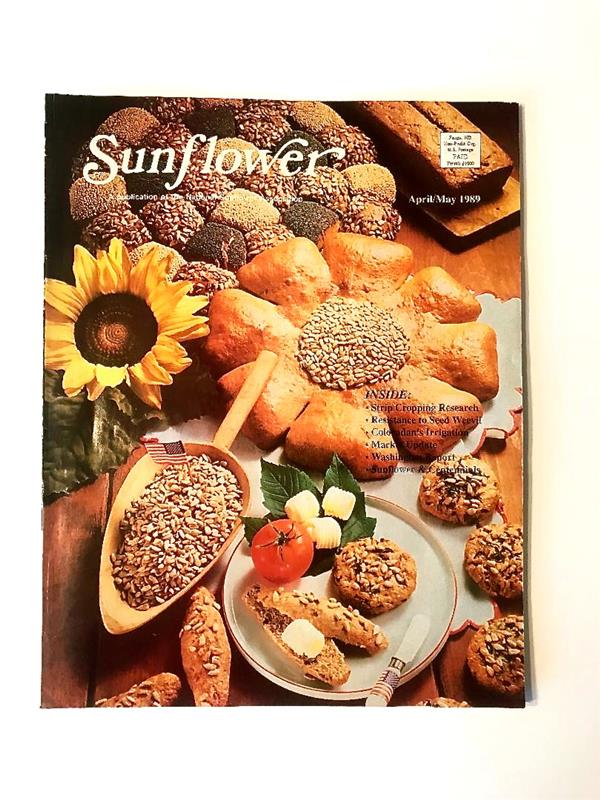Article Archives
30 Years Ago - A Look Back
Thursday, March 21, 2019
filed under: Historical
 Sweet Clover Between the Rows/ By Tracy Sayler —“Gary Throlson has planted sweet clover and cultivated sunflower. That’s nothing out of the ordinary — unless you consider he did both in the same field at the same time.
Sweet Clover Between the Rows/ By Tracy Sayler —“Gary Throlson has planted sweet clover and cultivated sunflower. That’s nothing out of the ordinary — unless you consider he did both in the same field at the same time.
“Throlson, who farms near Sheyenne in central North Dakota, is one of the Eddy County Soil Conservation District supervisors. He came up with an idea of incorporating sweet clover seed between sunflower rows as he cultivated. His main goal was to add soil tilth, organic matter and nitrogen in the soil. Providing winter and spring soil cover was another positive factor.
“Throlson first decided to try the concept in 1981. He attached his Herd broadcaster to the front of his tractor, filled it with sunflower seed, and went out to seed sweet clover and cultivate his sunflower crop in late June. He seeded at a rate of 12 pounds an acre. The broadcaster covered 18 feet, about the same width of his cultivator.
“Throlson says that he had good success with the practice in 1981. The next year he had some winter and spring freeze on the clover. Treflan carryover from the sunflower crop gave excellent weed control, and the Eddy County farmer even combined his sweet clover one year.
“He disked the blooming sweet clover under for fertilizer the following year after planting. Throlson says the soil measured 125 pounds of actual N after the disked-under sweet clover crop turned to humus.”
Narrow Strips Hike Yield/ By Larry Kleingartner — “Strip cropping has been a common farming technique in controlling erosion in the Midwest since the ‘dust bowl’ days of the 1930s. Now cropping in strips is being researcher as a farming practice that may increase yields and also control the level of disease and insects and possibly erosion.
Researchers at the [NDSU] Carrington, N.D., Research Extension Center, located in the central part of the state, have been looking at a unique cropping system in which six rows of sunflower are alternately strip cropped with six rows of soybeans in the same field. The first research was in 1988 on a 15-acre plot; and because of encouraging results, plans are to expand that in 1989.
“The researchers chose sunflower and soybean because of the compatibility of the two crops in terms of herbicides and planting dates. John Gardner, superintendent of the center, explains they were confident that a sunflower yield increase could be obtained because of the crop’s ability to compensate for the edging effect — growing a larger stalk and head. . . .
“In the 1988 trial, the strip-cropped sunflower yielded 1,740 pounds an acre and the soybeans 20 bushels an acre. In comparison to mono-cropped fields, this is a 240-pound increase on sunflower and a three-bushel increase for the soybeans. Gardner says the sunflower yield increase was expected but the soybean increase was not. . . . ‘[We] think the protection from the hot south wind and shading from the sunflower helped the soybean yields,’ he relates.
“Another benefit in the 1988 plot was the low level of seed weevils of two or three weevils per head in the sunflower. This compares to 10 to 12 weevils per head in an adjacent 300-acre field.”
Irrigation Gives Farmer Unique Rotation Options/ By Larry Kleingartner — “Although sunflower does not have the same yield response to irrigation as do corn and alfalfa, some sunflower is being produced under irrigation. Part of the reason is a cost savings since two or three waterings can often be sufficient to obtain excellent sunflower yields. Another reason is water conservation in an area where the aquifer is dropping. The cost of electrical power to pump water is also a factor.
“But for Milbert Beringer of Bethune, Colo., sunflower in a rotation with other crops gives him an optimum use of his land and investment.
“Beringer . . . operates eight central pivots, or ‘circles’ as he calls them, that each cover 120 acres. Beringer grows only confection sunflower under the circles and grows oils on his non-irrigated acreage. The addition of irrigation for his confection sunflower ensures more uniform seed size to help him gain top market prices. . . .
“But the real reason for adding sunflower to his irrigated rotation is it allows Beringer to harvest four crops in three years. Those crops include corn, sunflower, wheat and winter turnips. Yes, that’s right — turnips! These are the regular purple-topped turnips. He doesn’t harvest the turnips for the local supermarket. He buys oil cull cows and turns them into the turnips for grazing. . . . “Beringer says he will irrigate the turnips up to three times after the crop is seeded in early July [depending on rainfall]. By October-November the turnip crop is established and he heads for the local livestock markets looking for old skinny cull cows. ‘I generally put 150 cows in each circle. They eat the volunteer winter wheat first and then eat the fruit part of the turnip which grows above ground.’ He leaves the cows in the turnip field for 60-90 days depending on the market, the weather and the rate of gain. He looks for a 200-pound weight gain. For the last several years the market price has been in his favor as well, going up after the cows were purchased. His goal is to net $100 per cow on a five-year average.”